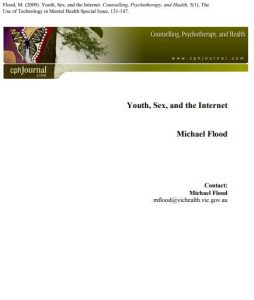Shaping Sexual Behaviors & Sexual Scripts
Youth, Sex and the Internet
 Full Article Name: Youth, Sex and the Internet
Full Article Name: Youth, Sex and the Internet
Open Access: Yes
Abstract
For young people, the Internet is a space of both pleasure and danger. On the one hand, the Internet fosters a wide variety of social and sexual interactions, delivers responsible information and advice on sexual and reproductive health, allows the exploration of diverse sexualities, and is a means of sexual pleasure and expression. On the other hand, the Internet has facilitated young people’s unwanted exposure to sexually explicit content and increased their vulnerability to forms of emotional and sexual abuse. Research by the Australia Institute finds that three-quarters of 16 and 17 year-olds have been exposed accidentally to pornographic websites, while 38 per cent of boys and two per cent of girls have deliberately accessed such sites. Much of the sexually explicit material available online, like much pornography in general, presents a narrow and distorted view of sex, shows women in sexist and stereotyped ways, and some material depicts and eroticises violence. Government regulation of the Internet has failed to keep pace with its development, and the Government thus far has done little to lessen the potential harms young people face. At the same time, the Internet is proving to be an increasingly important tool in building young people’s health. To make the most of the Internet, we need to teach skills in media literacy, produce and deliver youth-focused materials on sex and relationships, and adopt regulatory strategies to minimise the harms associated with young people’s exposure to sexually explicit content.
Citation
Flood, M. G. (2009). Youth, sex and the internet. Counselling, Psychotherapy and Health, 5(1), 131-147. https://eprints.qut.edu.au/103818/1/103818.pdf
